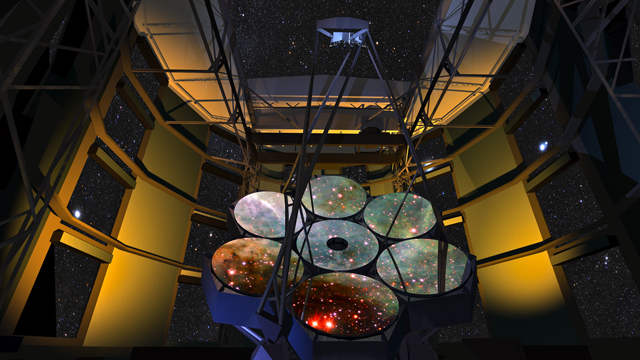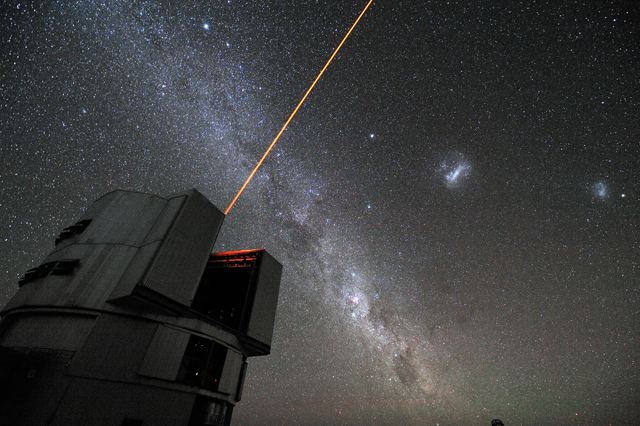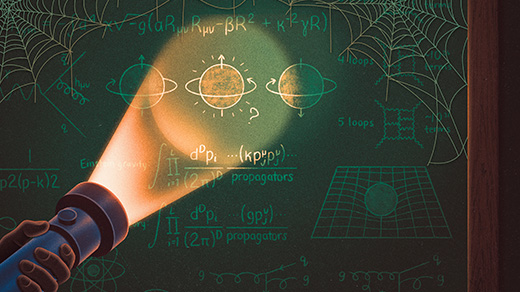Peering Into the Early Universe

From the properties of dark matter to how the universe took shape shortly after the Big Bang, some of the universe’s oldest and best-kept secrets could soon be exposed as construction moves forward on three “extremely large telescopes,” each with an expanse of mirrors bigger than a basketball court.
Scientists hope the competing telescopes — all expected to be running within a decade — will enable them to observe the early universe as it transitioned from a uniformly hot and opaque beginning to a cool, structured state, in which matter became concentrated inside objects, setting light free to roam the cosmos.
“We’re basically talking about the gap between 100 million and 500 million years after the universe began; that’s the time when the first stars and chemical elements and black holes and other exotica came into existence for the first time,” said Gerry Gilmore, an astronomer at Cambridge University.
The huge telescopes will look back in time at some of the earliest light ever emitted by objects. The universe inflated like the surface of a balloon shortly after the Big Bang, and some places stretched so far from here that their first bursts of light are only now arriving. Resolving this light would reveal the structure and chemical makeup of the universe’s first objects, which, as faint images from the Hubble Space Telescope suggest, developed much earlier than current theories would predict. Better observations are likely to lead to new theories of the birth and evolution of space and time, Gilmore said.
At projected costs ranging from $900 million to $1.6 billion each, the Giant Magellan Telescope, the Thirty Meter Telescope and the European Extremely Large Telescope — which will have segmented mirrors measuring 24.5 meters, 30 meters and 39.3 meters across, respectively — will dwarf existing optical telescopes (the current largest is 10.4 meters). They will be between 5 and 200 times more powerful, depending on the telescope and the task.
Universities, government agencies and other scientific organizations around the world are contributing funds to their project of choice in exchange for a future share of telescope time, explained Patrick McCarthy, an astronomer at Carnegie Observatories in California and director of the GMT project. Having a share will assure an institution’s standing in the field for decades to come, according to several astronomers unaffiliated with the projects. “If you’re one of the have-nots, you have to figure out something else to do to remain competitive,” McCarthy said.
Even as the three projects seek additional funding, they are treading into the early stages of construction. GMT project engineers leveled their mountaintop site in Chile last spring; in October, they finished fabricating the first of seven curved mirrors that will form the telescope’s segmented eye. Meanwhile, the TMT and E-ELT projects (to be built in Hawaii and Chile, respectively) are fabricating test mirrors. All three groups have begun developing their instrumentation.
The similar schedules promise intense competition, and yet, with each telescope boasting unique size or design advantages, it’s not all about which one switches on first. “We know there’s enough discovery space out there that if you’re three years later, you haven’t wasted a billion dollars,” said David Silva, director of the National Optical Astronomy Observatory in Tucson, Ariz., a facility funded by the National Science Foundation, which is in talks with the TMT about the possibility of a future partnership.
The telescopes will be powerful enough to witness the hustle and bustle of other worlds. “Exoplanet exploration is an area where we’ve just scratched the surface, and it’s going to burst wide open with these telescopes,” said Roger Angel, an astronomer at the University of Arizona who is overseeing the fabrication of the GMT’s mirror segments.
The telescopes will monitor spectral changes that could signal seasonal variation — and thus, an active atmosphere — on planets orbiting other stars. They could even tease out the chemical signatures of extraterrestrial life. “The expectation is that at the biochemical level, the signatures of life will be fairly universal,” McCarthy said. Whereas the Curiosity rover looks for these signatures by digging in the Martian soil, “we will do the same thing but do it remotely through spectroscopy for extrasolar planets,” he explained.
The ability to observe galaxy formation and the way matter clumps together across the cosmos will help put new constraints on the properties of dark matter particles — the invisible stuff thought to comprise 84 percent of the matter in the universe.
And by observing events in the most extreme environments in the universe — the edges of supermassive black holes — scientists also plan to test the laws of general relativity and quantum mechanics with unprecedented accuracy. “We will look at the radiation that comes from the annihilation of stars as they’re swallowed up by the black hole,” said Gilmore. “Whether photons turn up at a uniform rate or in little bunches tells us about the structure of space-time around the black holes.” This has never been possible before, he said, “because you need to home in very close to the black hole, and so you need very, very high resolution.”

These next-generation designs rely on a technology called adaptive optics, which removes the distorting effects of turbulence in Earth’s atmosphere on incoming light. “You use lasers to make artificial stars in the sky, and then treat them as references to determine the turbulence in the line of sight of the telescope,” Silva explained. Dozens of times per second, the turbulence measurement is used to reposition thousands of actuators attached to flexible mirrors inside the telescope, reshaping them to cancel out the atmospheric distortion. Smaller facilities, including the 10-meter Keck telescopes in Hawaii, already use adaptive optics. Scaling up the technology for telescopes two to four times larger in diameter “is at or beyond the bleeding edge of real-time computing,” Silva said.
If the technology works as planned, the GMT, TMT and E-ELT will resolve optical and near-infrared light — the dominant types of electromagnetic radiation in the universe — as sharply as if they were floating in orbit. The James Webb Space Telescope, which will launch in 2018 for a five-year mission at a cost of more than $8 billion, will complement these observations with greater sensitivity in the mid- and far-infrared range. But space telescopes are typically smaller, more expensive and shorter-lived than their grounded counterparts.
“It’s not inconceivable that these ground-based telescopes will have productive scientific lifetimes up to 50 years,” Silva said.
In that time, the trio of telescopes could reconfigure the fields of astronomy, physics and cosmology. In addition to the planned experiments, scientists hope to be surprised by unforeseen, paradigm-shifting observations, the way a previous generation of four-meter telescopes discovered evidence that a mysterious substance called dark energy pervades the universe. When the new telescopes are turned on, McCarthy said, “we’ll spend quite a while just staring out into some blank piece of sky and seeing what we can see that has never been seen before.”
This article was reprinted on Wired.com.



